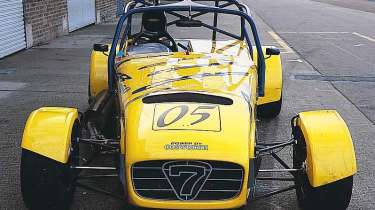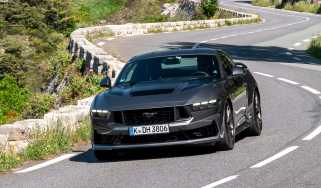Caterham
We drive the race version of the all-new, Cosworth-powered Seven
The road version of Caterham's new Seven CSR is still a few months off, but after driving the race version I can confidently predict that no-one will complain that it lacks power. The new Cosworth-tuned engine is a bespoke 2.3-litre Ford Duratec in-line four that will be offered in two states of tune; an EU4-friendly 200bhp version and, as tried here, the full-house 260bhp. Ponder that last figure for a moment. The most potent Sevens offered by Caterham until now have been the outrageous early '90s JPE (Jonathan Palmer Evolution) with its burp-chug-parp-BWAAARP! de-tuned Vauxhall Touring Car engine, and last year's wild R500 Evolution, both of which offered 250bhp. At a whopping £42K, the Evo has found just three buyers. The CSR 260 will have another 10bhp, a skipful more torque, and will cost £34K (£28,500 for the CSR 200). And as well as that stonking engine the CSR will also feature the new all-independent suspension chassis, aerodynamic developments and a new interior. It's no shock, then, to find that so far Caterham has orders for almost 100 CSRs - 19 race cars and 78 CSR road cars in both states of tune. We've turned up at Donington Park on a chilly December morning to drive what is very nearly the definitive CSR 260 racer, which next year will have its own six-round, 12-race endurance-style European race championship, titled the Caterham Masters. It's our first chance to try the new Cosworth engine and also to catch up with chassis and aero developments since we drove the original race-car prototype over a year ago (evo 062). In typical fashion, Jez Coates, Caterham's technical director, delivers a scene-setting one-liner for me to chew over as I wriggle into my race overalls: 'It was wet when we were here last and we were getting wheelspin in sixth...' Happily, by the time both the car and I are warmed up, the initially damp track has dried. Although the asphalt is still very cold and the CSR's fat rear slicks are nowhere near their optimum temperature, traction is strong enough to allow full power in all the gears. The new Seven's straight-line pace is colossal, a fact made even clearer by the company it finds itself in. This test day is almost entirely populated by wings-and-slicks single-seaters, up to F3 level, and the CSR blasts down the straights fast enough to keep most of them behind. It's clearly not too shabby through the corners, either. What we have here is effectively the second-wave development of Caterham's all-independent Seven. The first wave was in full swing when we drove that original prototype, when the new chassis was powered by a 200bhp R400-spec Rover K-series engine. The handling was good but traction needed work, so the suspension had to be refined. An engine deal was still to be brokered, but time was short - a batch of race versions of the new, wide-body car had been promised for a French race series. While the in-board front suspension was little touched, the rear was enhanced in a number of ways. Avon produced a wider, 10in radial slick, a number of limited slip differentials were tried before a recalibrated ZF plate type was selected, and the upper wishbones were made some 177mm shorter to more than double the roll-on camber effect. In an unequal-length double-wishbone set-up, when the suspension compresses in cornering, the shorter upper wishbone induces a camber change that helps keep the footprint of the loaded tyre flatter to the road surface, increasing grip. The results were positive. While the French series went ahead with the K-series, the chances of it meeting Caterham's requirements for the road car looked slim. The 160bhp VVC was the most potent K-series Rover had homologated and Caterham was looking for an emissions-compliant 200bhp. In February, Caterham struck a deal with Cosworth Racing for the supply of just such an engine. The Mondeo's 1.8 and 2-litre Duratec had been looked at, but the inlet manifold precluded the left-hand-drive version Caterham wanted to produce. Cosworth undertook to make a new manifold, pick suitable components from the Ford parts bin and homologate the EU4-spec engine. Thus the CSR was born, and a relationship with Cosworth was rekindled. What the initials stand for is debatable - 'Cosworth or Caterham, Seven, Racing... whatever,' says Caterham MD Simon Nearn. 'They sound good together.' The reason both the road and race CSRs will cost so much less than comparably powerful K-series Sevens (the racers will cost £28,500 + VAT) is because the bigger capacity Cosworth-Ford engine makes its power at lower revs. It's a costly exercise tuning the long-stroke 1.8 K-series to spin to over 8000rpm and make really big power, because this demands expensive, lightweight reciprocating parts and precision balancing. Cosworth's work on the Ford engine involves fitting new cams and pistons but the crank and rods are untouched. There is a dry sump system with all pumps internally mounted, Caterham's roller barrel throttle system and a bespoke MBE engine management system. Also, since the car was shown at the launch, ground clearance has been improved by designing a flatter oil filler cap, allowing the engine to be mounted higher. The Cosworth engine sounds similar to the K-series, with a strong, guttural bark when you crack the throttle wide open. It idles cleanly and hauls through the mid-range with terrific vigour, power and torque building progressively and punching the 540kg Seven forward with ever more neck-straining urge. The quoted outputs are 260bhp at 7500rpm backed up by 200lb ft at 5250rpm, which compare with 250 and 170 for the R500 Evo. A few laps in, there is at least some warmth in the slicks and the chassis feels calm and collected, and somehow better keyed into the Tarmac than the original red prototype. The rear feels planted and will take full throttle very early in the corners, and even upshifting from fourth to fifth through the slight kink after the Old Hairpin doesn't cause the CSR to squirm. Even more impressive are the brakes. The biggest stop, for the chicane before the pit straight, is from around 140mph in sixth, and for the first half dozen laps I'm braking far too early. It's a very fast but friendly and driveable car, and my only complaint is that there's a bit too much understeer on the entry to the corners. A little toe-out is dialled in to warm the tyres up a bit and the CSR instantly feels better. I'm not here to break any records - there are other drivers here today to try the car - yet in about eight laps I'm down to an impressive 1min 14sec dead. Four laps more and it's down to a 13.4, and this on a cold day which won't allow the slicks to get up to temperature. On a warmer day and with a bit more time in the car I could easily be down to low 12s or high 11s. For reference, the current lap record for the R400 racer is 14 dead, and that was probably achieved with an aerodynamic tow or three, such is the nature of Caterham racing. The pace of the CSR racer, its price and the championship format (two, two-driver races at six of Europe's finest race tracks) will make it an instant hit, I reckon. That, and the fact that, like all Sevens, the CSR is fun, with wonderful, feelsome handling and benign behaviour beyond the limit. And that bodes well for the road car, too, which will be identical to the racer apart from its suspension bushes and tyres. 'Racing really does improve the breed - no bullshit,' says Coates. It's hard to argue with that.
Specifications
| Engine | In-line 4-cyl, 2261cc, 16v |
| Max power | 260bhp @ 7500rpm |
| Max torque | 200lb ft @ 5250rpm |
| 0-60 | 3.1sec (claimed) |
| Top speed | 155mph (claimed) |
| On sale | Now (road car due in Spring) |



